Achieving eGovernment with the Government GatewaySM - The Portland Hub
Transitioning the City of Portland to e
Government Challenges
Governments currently face many challenges in today's new economy. Citizens have become less tolerant of government apathy in light of new technology and the streamlined responsiveness of many eBusiness companies. Governments have been criticized for years for being overly bureaucratic, difficult to deal with, and slow. With advances in technology and the widespread acceptance of the Internet, today's government officials can no longer stand idly aside as public pressure mounts to fix these problems. Progressive governments must adopt a mentality of change and commit to a strategic plan to streamline processes, integrate disparate systems, and most important create a citizen-friendly government.
What's eGovernment
An eGovernment is a government who has streamlined and electronically enabled their processes to realize the following benefits:
Most of the above benefits can be summarized into improving government image and reducing operating costs.
What's the Government Gateway
The Government Gateway is Convergent Group's blueprint for eGovernment solutions. The Government Gateway combines leading edge technology for front and back office applications with best-in-class government processes. Convergent Group has leveraged experience on over 1,000 government projects to define what the best-in-class processes are for government areas like:
Convergent Group has now completed the vision by providing a Customer Relationship Management (CRM) layer that links users (citizens, legislators, businesses, and employees) to the information and functionality they need.
The Government Gateway CRM layer provides users with blended media access. Users interact with the Government Gateway through a portal. The Government Gateway supports the following types of portals:
Regardless of what portal a user employs all of their actions are monitored and managed by the centralized CRM system. For governments and businesses that maintain disparate systems, centralization of the CRM system alleviates customer contact tracking problems.
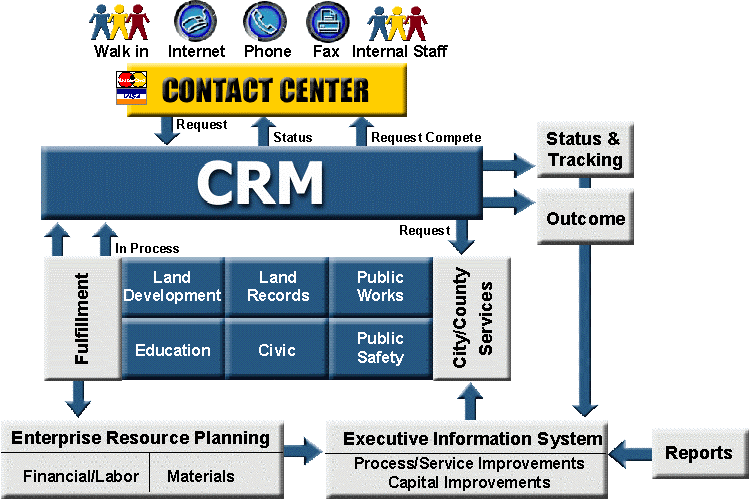
To implement the Government Gateway, Convergent Group uses a model office approach to rapidly deliver a fully integrated suite for eGovernment. This approach leverages working solutions, comprised of best practices processes for government and proven technology applications that support these processes. The model office aims to provide 80 percent of a total eGovernment solution "out-of-the-box". The remaining 20 percent of the solution will be defined by performing a gap analysis against the "out-of-the-box" functionality and the specific needs of the individual government. This custom functionality will then be implemented, tested, and delivered. This configuration-based approach provides the following benefits:
ArcInfo 8 and The Government Gateway
The Government Gateway does not try to implement functionality that already exists in other commercial software made for government. Rather the Government Gateway integrates them together so that single business processes that span more than one system do not require multiple data entry.
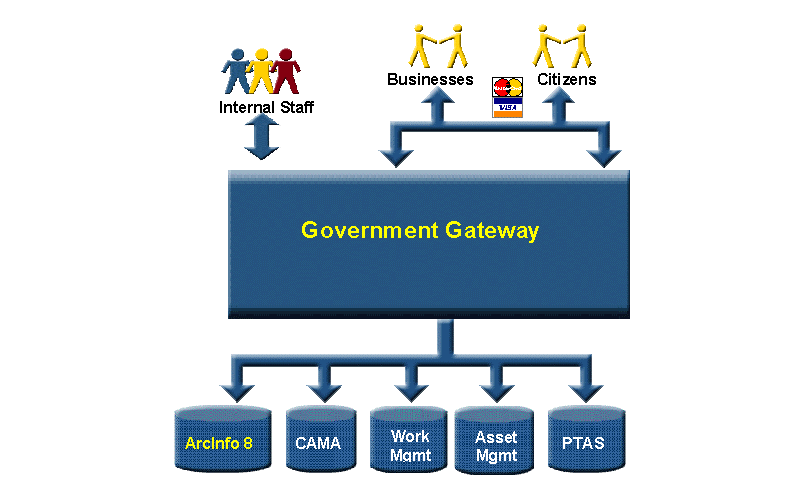
ArcInfo 8 and the Geodatabase allow easy integration of information contained in an external system into the correlating Feature Class. ArcInfo 8 provides the geographical representation and spatial operations for entities managed by Government Gateway that require a spatial representation. By implementing Custom Feature Classes or through an Import/Export mechanism data maintained in external systems needed for mapping may be brought seamlessly into the GIS.
For instance, consider a parcel. A parcel has a geographical representation and has associated PTAS and CAMA data that are most likely maintained in one or more separate systems. This data can easily be brought into an ArcInfo 8 Geodatabase and used to draw a map or perform spatial analysis by using the functionality of a Geodatabase and ArcInfo 8.
By providing a robust COM-based API, ArcInfo 8 establishes itself as an open system, which can easily integrate into heterogeneous environments. Given the extremely mixed environments that the Government Gateway must sometimes integrate, ArcInfo 8 becomes the choice GIS for achieving an eGovernment.
One of the first steps in becoming an eGovernment with the Government Gateway is the consolidation of spatial data into ArcInfo 8. Although it is simple to say, it is often a quite daunting task, considering large-scale data conversion and the always-present resistance to change in any organization. One must look for a way to ease the organization into new frontiers and that is exactly what the City of Portland is successfully doing.
City of Portland - The Enterprise GIS Hub
Faced with the problem of sharing enterprise data between the many bureaus and agencies within its jurisdiction, the City of Portland in Oregon has developed an innovative Internet-enabled solution that allows all parties access to City information without migrating from their current mix of data maintenance systems.
The City of Portland has solved the problem of sharing data by providing an enterprise data warehouse. The Enterprise GIS Hub (EGH) that has been developed by Portland is a high availability spatial database that provides online Internet access to the City's enterprise data sets. In addition to the internet browsing and querying capabilities the Hub provides a Web-based data extraction page that permits the user to obtain a copy of the data of their choice, for any area of the City and in the format of their own GIS system. They may then import the data directly into their own systems and use it natively. The beauty of the approach is that all bureaus can use any of the City data sets without the difficulty of having to migrate to a new system.
Challenges and Problems
Bureaus within the City of Portland use a rich mix of spatial data systems including ARC/INFO, Microstation, AutoCAD, MapInfo and ArcView. Tabular information is managed within a variety of databases such as Access, Oracle, SQLServer, Sybase, etc.
This mix of systems has caused the exchange of data between bureaus to be difficult. This led to a number of problems as City personnel found themselves spending increasing effort in tracking down data and verifying it for accuracy and currency as well as servicing requests for their own data from other bureaus.
Inevitably bureaus found themselves maintaining their own copies of the enterprise data sets for use in their own systems. Bureau data maintenance engineers had less time to spend maintaining the bureau's core data sets and this led to maintenance backlogs and data currency issues.
In the face of increasing costs and duplication of data, the City's GIS Management Committee championed the notion of a multiple-platform GIS data warehouse to serve the enterprise data-sharing needs of all bureaus.
The Solution
CGIS contracted Convergent Group, a spatial systems integrator in Englewood, Colorado to architect and build a pilot system to demonstrate the strengths of the data warehouse approach. The Hub stores enterprise data within a Spatial Database Engine (SDE)-enabled database hosted by Microsoft's SQLServer. SAFE Software's Feature Manipulation Engine (FME) provides spatial data translation services to translate source data into the Hub and also to translate Hub data into the many extract formats supported by the Hub. SQLServer's native replication functionality is employed to replicate the enterprise data to all participating Hub servers to provide local copies of the data to all user groups. GeoNorth's MapOptix Internet Map Server is used to serve the Hub data to the Internet as well as to configure user access to data and Hub functionality. City personnel do not require any additional software; they can view the data online using a standard Web browser. Client access to the Hub data is facilitated through the application development and customization activities of Portland's CGIS team.
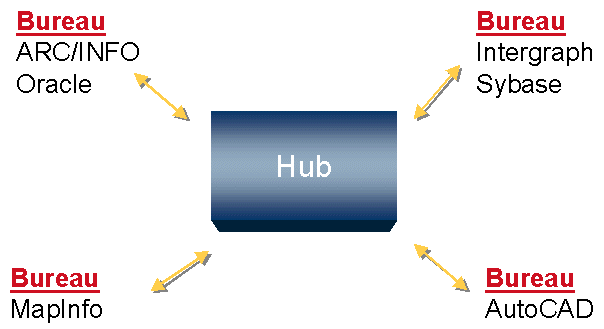
The Enterprise GIS Hub allows City bureaus to share information from the comfort of their own environments.
Implementing an enterprise system based on such a rich mix of vendor technologies has been a significant integration challenge that required the cooperation and commitment of the vendor parties, which in some cases has meant the release of enhancements to vendor products. Of the technological challenges that have been overcome in the development of the Hub, perhaps the greatest has been the replication of SDE data between Hub servers.
Data replication provides a number of advantages including local repositories for main user groups, scalability through additional database servers and availability through the use of load balancing software to automatically distribute requests based on the available databases and their work load. Data replication is a cornerstone of the Hub architecture that required significant investigation of SDE before it could be accomplished in all its flavors. The lessons learned during this part of the project have been fed back to the SDE development team at Esri in an effort to facilitate the support of replication in later releases of SDE.
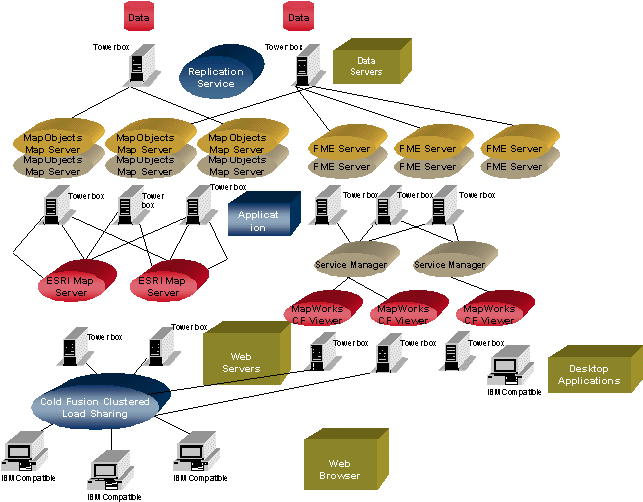
The robust architecture of the Hub has been designed to scale to meet the growing demands of the City and to provide data access 24 hours a day to satisfy the City's mission-critical systems.
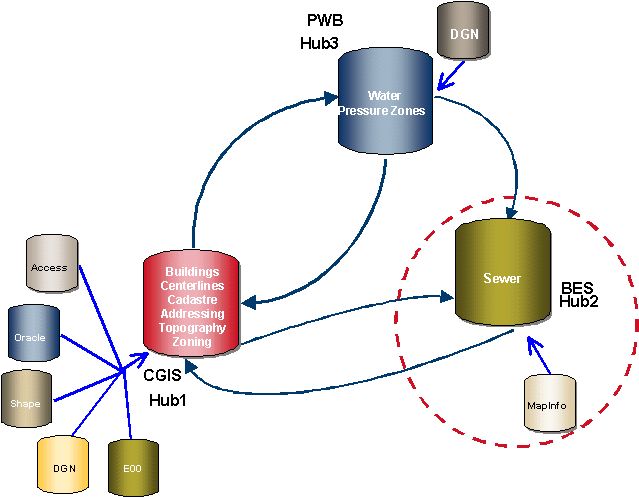
The Hub's inherent replication scheme insures that the data on all participating Hub servers is automatically synchronized.
Moving Forward to eGovernment
The story could end here with the success of the multiple-platform Enterprise GIS Hub. But not for Portland; the City sees the Hub as providing a stepping stone in the route to a single citywide maintenance platform. The City recognizes that migration to a single platform is necessary in achieving the ultimate goal of eGovernment through cost savings, improved data reliability, and integrated business processes.
The platform that has been selected by the City is Esri's ArcInfo version 8 running on ArcSDE. Throughout the migration to ArcInfo8 the Hub will provide a central source for all enterprise data, providing the City with a breathing space in which to implement the single platform. Utilization of the Hub during this period will guide the development of the single platform by providing the opportunity to identify enterprise data sharing issues. The Hub will persist beyond the deployment of the single platform, however, and will continue to provide a one-stop Internet shop for all enterprise data sets for City bureaus, clients, and ultimately, the general public.